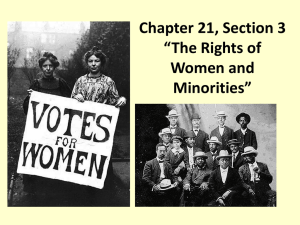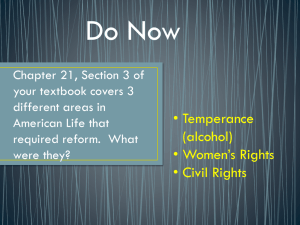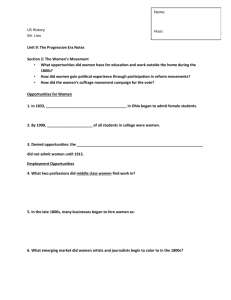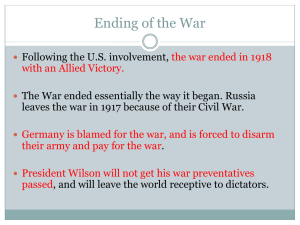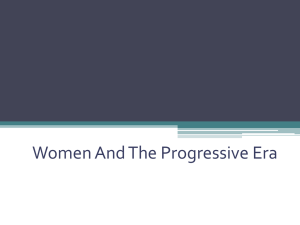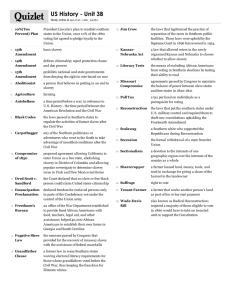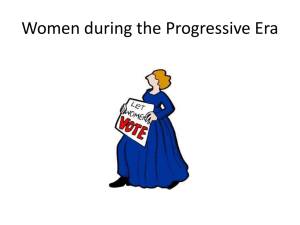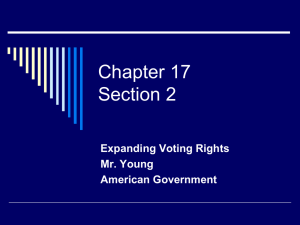Chapter 21, Section 3 “The Rights of Women and Minorities” Female
advertisement
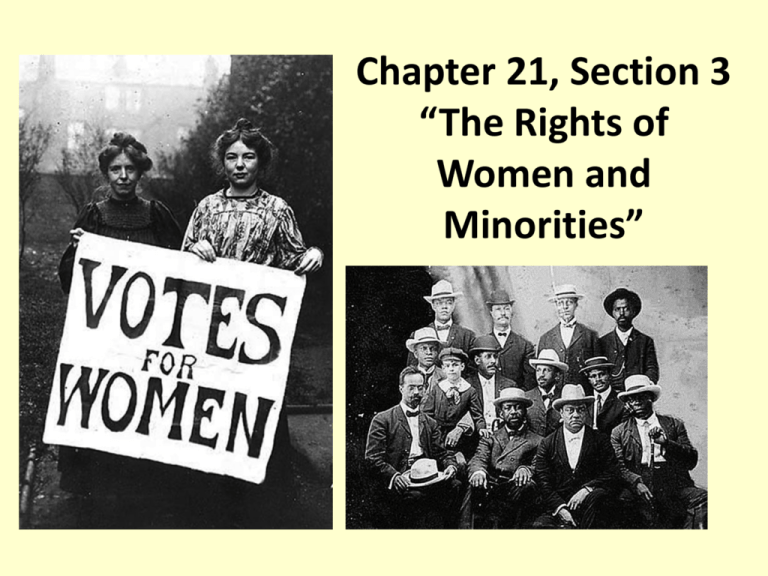
Chapter 21, Section 3 “The Rights of Women and Minorities” Female Progressives • Women began attending women’s colleges in larger numbers in the late 1800s (nearly 40% of college students were women by 1910) • Women were excluded from fields like law and medicine that were dominated by men • Many women college graduates entered fields such as social work and education and often put their education to use by becoming active in reform movements Vassar College Students in 1887 in New York Smith College in Massachusetts Temperance • Woman’s Christian Temperance Union – reformer group founded in 1874 that fought for the adoption of local and state laws restricting the sale of alcohol • Carrie Nation – radical temperance fighter in 1890s Kansas who would storm into saloons with a hatchet and smash liquor bottles • 18th Amendment – amendment to the US Constitution passed in 1919 it banned the production, sale, and transportation of alcoholic beverages throughout the US Opposition to Female Suffrage • suffrage – the right to vote, which women reformers began to push for again in the late 1800s and into the 1900s • Reasons for opposition: – Political bosses were worried about the anti-corruption efforts of women – Some business leaders worried women would support minimum wage and child labor laws – Others believed women should only be homemakers and mothers and not politically active citizens The Suffrage Movement • Women failed to gain the right to vote following the Civil War (when African Americans did get it) • Elizabeth Cady Stanton and Susan B. Anthony founded the National American Woman Suffrage Association (NAWSA) in 1890 to promote the cause of women’s suffrage • Some women earned the right to vote on a state-by-state basis – Wyoming was first in 1890, followed by Colorado, Idaho, and Utah 19th Amendment • Carrie Chapman Catt – Pres. of NAWSA in 1900 who helped mobilize more than 1 million members, and pushed for more states to allow women the right to vote • Alice Paul – founded the National Woman’s Party in 1913 and used parades, demonstrations, picketing (including on Pres. Wilson during WWI), and hunger strikes to draw attention to the movement • 19th Amendment – U.S. Constitutional amendment that granted women the right to vote in 1920 Alice Paul Celebrating Ratification of 19th Amendment African Americans Faced Discrimination • African Americans were relegated to sharecropping in the South and working for the lowest wages in the worst jobs in the North • Jim Crow laws – set up segregation which separated races in public places in the South • Barriers to voting: – Literacy Tests – difficult, nearly impossible test to determine ability to read/write. – Poll Taxes – fee charged to Blacks only for the purposes of voting – Grandfather Clause – voting rule that stated you could vote as long as your grandfather had the right to vote African American Leaders vs. Discrimination • Booker T. Washington – late 1800s educator who founded the Tuskegee Institute in Alabama, who fought discrimination by encouraging African Americans to improve educational and economic conditions before asking for full rights • W.E.B. Du Bois – a Harvard University graduate who called for direct action and protests of racial injustice, who also became a founder of the NAACP in 1909 Lynchings • Lynching: Racially motivated murders, usually inflicted upon African-Americans for violation of social codes (more than 3,000 African-Americans lynched between 1885-1915) • Ida B. Wells – African American journalist who wrote for a Memphis newspaper, who wrote articles about the unequal economic and educational opportunities for African Americans and about lynchings – She later moved to Chicago due to continual death threats Organizations Aid African American • N.A.A.C.P. – (National Association for the Advancement of Colored People) an early civil rights group founded by reformers including W.E.B. DuBois in 1909 that attacked discrimination through court cases (including winning one that ended the grandfather’s clause that restricted African American voting) • National Urban League – organization founded in 1911 that aided African Americans moving from the South by helping them find jobs and housing in Northern cities Other minority groups struggled to assimilate and achieve equality • Reformers who helped these groups tended to encourage them to adopt the ways of European society • Conflicting Native American groups were set up – some promoted integration and some supported preserving their traditional culture • Chinese immigrants organized neighborhood associations to provide public services that white reforms denied them • Mexican immigration increased into the South and these people became an important part of the economy there, but they rarely benefitted from the progressive labor laws of the time period
